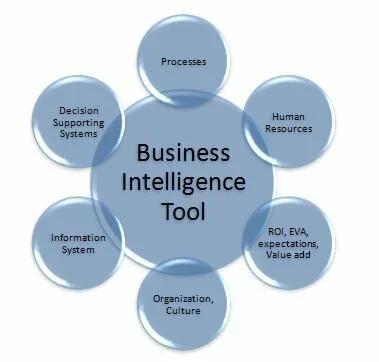What is Business Intelligence and what’s the utility of BI Tools?
Business Intelligence (BI) is defined as any real-time, current, or past information that helps various business professionals including managers analyze current/past activities to assist in predicting future courses of the company’s business.
Business Intelligence is thus a stream of knowledge and hence it requires sorting also as analysis before it’s suitable to be used during a company’s decision-making process. Such sorting and analysis of relevant data are typically administered by software solutions, to make sure superior speed and accuracy of the info collection and analysis procedure.
Any and every one software solution aiding the method of generating Business Intelligence for an enterprise is termed as Business Intelligence Tools. So BI data can help an enterprise rapidly suits changing business environment, while BI tools make sure that the changing business environment is rapidly also as correctly identified and reported to facilitate a streamlined decision-making process. Just in case of historic data, BI tools usually sort and analyze data, which was previously stored within the enterprise database.
Commonly Used Business Intelligence Tools
BI tools are commonly classified into the subsequent categories:
• Local Information Systems
• Business Performance Management
• Process Mining
• Dashboards
• Online Analytical Processing (OLAP)
• Data Warehousing
• data processing
• Reporting and Querying Software
• Spreadsheets
Most of those Business Intelligence technology and tools aside from spreadsheets are available as a part of software suitable for a selected industry, standalone solutions, ERP system components, or as a BI software suite.
These solutions are often developed by a custom development company in response to requirements specified by a client or detected after a radical analysis of the company’s business model.
A couple of open-source business intelligence tools also are available, however, most enterprises like better use proprietary business intelligence technology to make sure adequate protection of critical data. The sort of business intelligence architecture implemented by a corporation varies on the industry, market conditions also as specific market requirements.
A number of the commonly available BI tool categories are described here:
Local Information Systems
The term Local data system (LIS) originated from its use within the public sector of the UK; other terms used synonymously with LIS in several parts of the planet include – Data Observatory and Community information systems.
Within the global business intelligence technology market, LIS applications are usually limited to providing support for geographic reporting of enterprise operations. The functions supported by LIS tools often overlap with a number of the features of Geographic Information Systems and Knowledge Management tools.
Business Performance Management
Business Performance Management (BPM) refers to a group of management also as analytical processes designed to facilitate the improvement of a company’s processes in accordance with the preset goals of the organization. Such tools are capable of handling large amounts of knowledge and help managers in determining fruitful interventions designed to enhance the functioning of specific business processes.
Process Mining
Process Mining is usually defined as a process management technique that allows decision-makers to research business processes on the idea of obtainable event logs. These event logs are automatically generated by the enterprise event system and therefore the aim of Process Mining is to facilitate the improvement of overall performance by providing tools and techniques designed to spot social, organizational, control, and process structures by using the event logs.
The technique is preferred if other conventional techniques fail to provide adequate insight into an enterprise process. Process Mining features in certain contemporary management techniques like Business Process Intelligence, Business Operations Management, and commercial activity Monitoring. Current Process Mining techniques are classified into the subsequent categories: extension, conformation analysis, and discovery.
Dashboards
Dashboards are defined as an easy read, real-time interface, which provides a snapshot of the present status of key business processes as a chart or graph. The dashboards are one among the foremost prolific and widely used tools for supporting informed and instantaneous deciding. Dashboards are capable of displaying a good sort of user-defined key performance indicators significant for various departments of a corporation.
A production dashboard can display the entire number of units produced, the typical rate of production per hour, number of produced units which failed inspection during a 1 month period then on. The key advantage of a dashboard is its capability to be customized to point out only the relevant data, which ends up in significant time savings during the method of deciding.
Currently available dashboards are commonly classified into three categories- desktop widgets, web-based applications also as standalone solutions, which feature sparklines, bullet graphs, pie charts, and/or bar charts to represent the info. Dashboards also are capable of being integrated into mobile business intelligence solutions to make sure seamless connectivity regardless of the user’s location.
Online Analytical Processing (OLAP)
OLAP tools are designed to assist users in interactively analyze multidimensional data from multiple perspectives. OLAP as a business intelligence method includes various aspects of knowledge mining and rational reporting. The term Online Analytical Processing may be a derivative of OLTP (Online Transaction Processing), which is employed in regard to traditional databases. Key analytical operations performed by these tools are- consolidation, drill-down, and slice ‘n’ dice. The consolidation process refers to the aggregation of knowledge to enable its analysis of multiple dimensions.
The drill-down technique enables users to navigate through large quantities on data to map out the relevant data. Databases with OLAP support utilize a multidimensional data model for supporting the rapid execution of both ad-hoc also as complex analytical queries.



